

|
| POLSKA | POLAND |
| województwo: Zachodniopomorskie | voivodship: West Pomerania |
| miasto na prawach powiatu: Szczecin | city: Szczecin |
Szczecin is situated at an elevation of 1.5 m at the Western Odra near the mouth of the river into the Lagoon of Szczecin. Szczecin is the capital of the voivodship Zachodniopomorskie (West Pomerania) and has a population of about 412,000 (2004). It is the seventh-largest city in Poland.
Since the 7th century the site was occupied by a Slavic settlement which, together with Pomerania, in AD 967 was conquered by the Polish prince Mieszko I of the Piast dynasty. In the 11th century Szczecin came under Danish rule, but returned to Poland in 1127. In 1164 it came in possession of Heinrich "the Lion", Duke of Saxony and of Bavaria. The town in 1243 was granted a charter based on the municipal laws of Magdeburg, and in 1278 it became a member of the Hanse federation of trading towns. In 1472 Szczecin (in German: Stettin) came in possession of the margraves of Brandenburg. After the Thirty Years' War (1618–1648) Szczecin and Vorpommern (Hither Pomerania) came under Swedish rule and remained so until 1720 when the whole region became Prussian. Except for a short period during the Napolenic times, the town remained Prussian until the end of World War II.
 The entire historic old town was destroyed during the war by fire which followed severe bomb raids by British and US American bombers.
Although the Potsdam Agreement between the USSR, the USA and the UK had determined the river Odra as border between Poland and Germany,
Joseph Stalin then ordered that the town and its surroundings west of the river had to be handed over to Poland because the town was an important trans-shipment place
for coal from Upper Silesia. The German-speaking population (about 98% before the war) was expelled. Only in 1990 the Federal Republic of Germany formally
abandoned any German claims to this territory.
The entire historic old town was destroyed during the war by fire which followed severe bomb raids by British and US American bombers.
Although the Potsdam Agreement between the USSR, the USA and the UK had determined the river Odra as border between Poland and Germany,
Joseph Stalin then ordered that the town and its surroundings west of the river had to be handed over to Poland because the town was an important trans-shipment place
for coal from Upper Silesia. The German-speaking population (about 98% before the war) was expelled. Only in 1990 the Federal Republic of Germany formally
abandoned any German claims to this territory.
The probably best-known daughter of Szczecin is Princess Sophie Auguste Friederike of Anhalt-Zerbst-Dornburg (later Empress Catherine II of Russia) who was born here on the 2nd of May, 1729. In 1744 she traveled to Russia to marry Grand Duke Peter Fjodorowich (Karl Peter Ulrich von Holstein-Gottorp), the successor to the Russian Throne, in the following year. After her conversion in 1744 to the Orthodox faith she changed her name to Jekaterina Alexejewna. In 1762 her husband, Czar Peter III since 1761, was assassinated with her approval and Catherine acceded to the throne as Catherine II ("the Great"). Catherine died on the 17th of November 1796 in Zarskoje Selo.
The  Brama Królewska (Königstor) (King's Gate) [left, no. 1684: top picture]
was built by order of King Friedrich Wilhelm I, King in Prussia (the "Soldier King"), in 1726–1728 on the site of the former "Mühlentor" ("Mill's Gate").
The ostentatious gate at first was given the name "Anklamer Tor" (Anklam Gate) and was created as a memorial to the
acquisition of Pomerania by Prussia. The architect of the gate was Gerhard Cornelius Walrave.
Brama Królewska (Königstor) (King's Gate) [left, no. 1684: top picture]
was built by order of King Friedrich Wilhelm I, King in Prussia (the "Soldier King"), in 1726–1728 on the site of the former "Mühlentor" ("Mill's Gate").
The ostentatious gate at first was given the name "Anklamer Tor" (Anklam Gate) and was created as a memorial to the
acquisition of Pomerania by Prussia. The architect of the gate was Gerhard Cornelius Walrave.
The  new town hall [left, no. 1684: bottom left picture: left] at ulica Dworcowa
was built in 1879 by the architect Konrad Kruhl. The representative building in Gothic revival style was destroyed in World War II but was restored
to the original appearance after the war. The park Grüne Schanze ("Green Redoubt"), now ulica Dworcowa ("Station Street"), was laid out after the fortifications of Stettin
had been put down in 1873.
new town hall [left, no. 1684: bottom left picture: left] at ulica Dworcowa
was built in 1879 by the architect Konrad Kruhl. The representative building in Gothic revival style was destroyed in World War II but was restored
to the original appearance after the war. The park Grüne Schanze ("Green Redoubt"), now ulica Dworcowa ("Station Street"), was laid out after the fortifications of Stettin
had been put down in 1873.
The bottom right picture on glass no. 1684 shows
 Deutschestraße
Deutschestraße
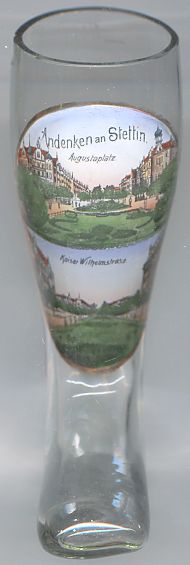
The picture on glass no. 2345 [near left] shows two views:
The top picture shows the square  Augustaplatz, today named plac Lotników.
The current Polish name means "Airmen Square".
Augustaplatz, today named plac Lotników.
The current Polish name means "Airmen Square".
The bottom picture shows the street  Kaiser-Wilhelm-Straße, after the war named aleja Jedności Narodowej.
The street was the largest street of houses in the Neustadt ("New Town") borough of Szczecin.
The street was named for Emperor Wilhelm I, the first German emperor; the current Polish name means "Boulevard of National Unity".
Kaiser-Wilhelm-Straße, after the war named aleja Jedności Narodowej.
The street was the largest street of houses in the Neustadt ("New Town") borough of Szczecin.
The street was named for Emperor Wilhelm I, the first German emperor; the current Polish name means "Boulevard of National Unity".
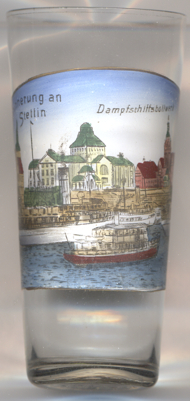
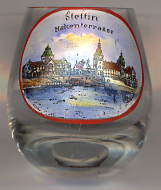 The
The  Hakenterrasse (today Wały Chrobrego, popularly still also Taras Hakena
in Polish) is one of Szczecin's best-known cityscapes. The ensemble created between 1900 and 1914 on the western bank of the
river Odra on the site of the former Fort Leopold and was named for Hermann Haken (1828–1916), lord mayor of Stettin
from 1878 until 1907, who had been responsible for Szczecin's transformation to a modern harbour town.
Hakenterrasse (today Wały Chrobrego, popularly still also Taras Hakena
in Polish) is one of Szczecin's best-known cityscapes. The ensemble created between 1900 and 1914 on the western bank of the
river Odra on the site of the former Fort Leopold and was named for Hermann Haken (1828–1916), lord mayor of Stettin
from 1878 until 1907, who had been responsible for Szczecin's transformation to a modern harbour town.
Depicted on the left is the
 Municipal
Municipal
Depicted on the right is the former  Government
Government
The older glass on the left [no. 3810] is labeled 'Dampfschiffsbollwerk', i.e. steamship landing.
[https://de.wikipedia.org/wiki/Hakenterrasse, https://de.wikipedia.org/wiki/Hermann_Haken_(Politiker),
https://de.wikipedia.org/wiki/Städtisches_Museum_Stettin, http://www.spatzier.net/reisebericht_stettin_cottbus_1.html]
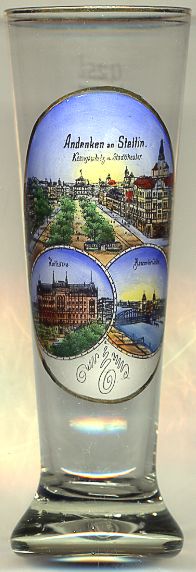
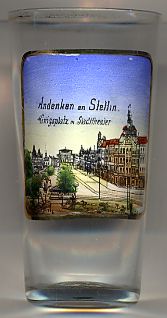
The picture on glass no. 2501 [right] and the top picture of glass no. 2544 [left] show a view of the square
 Königsplatz
Königsplatz
The  Stadttheater (Municipal Theatre) [background centre]
was built in 1846–1849 by Carl Ferdinand Langhans for the Stettin merchants' society.
In 1892 it was bought by the city of Stettin. In 1899 the front was extended by the addition of a foyer and staircase wing.
Backstage extensions and a renewal of the stage machinery were carried out in 1905–1906.
The theatre had a capacity of 800 seats (plus 170 standing). The building was damaged, but not destroyed by bombs in 1944.
Unfortunately, the remaining structures were not protected so that the building fell in ruins.
The remaining ruins were finally removed in the 1950s.
Stadttheater (Municipal Theatre) [background centre]
was built in 1846–1849 by Carl Ferdinand Langhans for the Stettin merchants' society.
In 1892 it was bought by the city of Stettin. In 1899 the front was extended by the addition of a foyer and staircase wing.
Backstage extensions and a renewal of the stage machinery were carried out in 1905–1906.
The theatre had a capacity of 800 seats (plus 170 standing). The building was damaged, but not destroyed by bombs in 1944.
Unfortunately, the remaining structures were not protected so that the building fell in ruins.
The remaining ruins were finally removed in the 1950s.
Another theatre built by C.F. Langhans, the New Theatre in Leipzig, is depicted on glass no. 698.
The  New City Hall [left, no. 2544: bottom left picture], also called the Red City Hall,
was built in 1875–1879 in Gothic Revival style.
Today it houses offices of the harbour administration, the Polish Chamber of Foreign Trade, the Institute of Meteorology and Water Management and others.
New City Hall [left, no. 2544: bottom left picture], also called the Red City Hall,
was built in 1875–1879 in Gothic Revival style.
Today it houses offices of the harbour administration, the Polish Chamber of Foreign Trade, the Institute of Meteorology and Water Management and others.
The  Baumbrücke ('Tree Bridge') [left, no. 2544: bottom right picture]
was one of the three main bridges that spanned the river Odra. The middle section of the steel bascule bridge could be opened to allow for the passage of ships.
The bridge was opened in 1909. It was blown up in April 1945 by the German Wehrmacht and was not rebuilt.
Baumbrücke ('Tree Bridge') [left, no. 2544: bottom right picture]
was one of the three main bridges that spanned the river Odra. The middle section of the steel bascule bridge could be opened to allow for the passage of ships.
The bridge was opened in 1909. It was blown up in April 1945 by the German Wehrmacht and was not rebuilt.
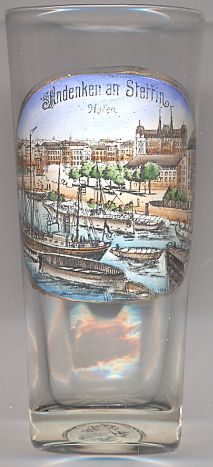
The picture on glass no. 2411 [left] show an old view of the
 harbour
harbour
Szczecin (Stettin) also has a long history as a ship-building place. The famous Vulcan shipyard was a pioneer of modern ship-building and was considered to be one of the leading ship-builders in Germany. Some of the ships built here are depicted on glasses of this collection: The famous teamships "Kronprinz Wilhelm" (1901), "Kaiser Wilhelm II" (1902) and "Kronprinzessin Cecilie" (1907) of the Norddeutscher Lloyd company (the fourth of the "Flying Sisters", the "Kaiser Wilhelm der Große" is missing in this collection) are described on the Bremerhaven page, the "Deutschland" (1900) and the "Kaiser" (1905) of the HAPAG (Hamburg-Amerikanische Packetfahrt-Actien-Gesellschaft) are described on the Hamburg page.
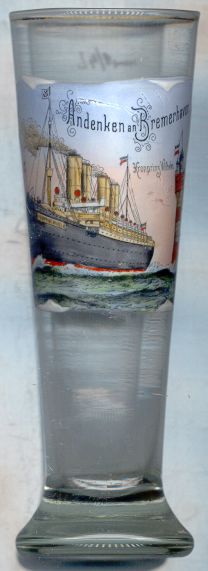
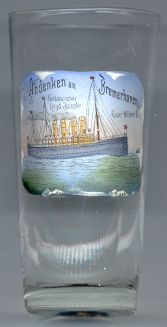
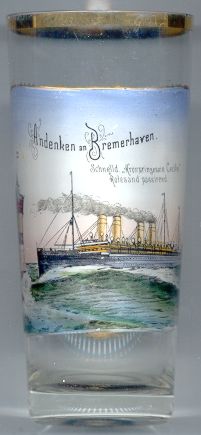
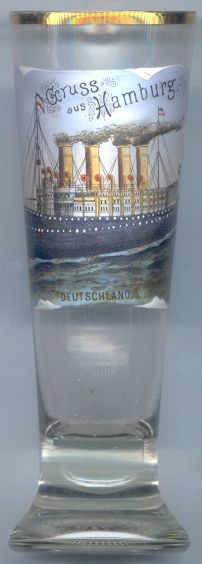
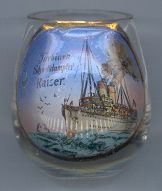
![[scale]](lineal.jpg)